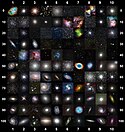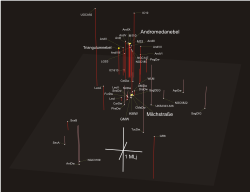Andromeda galaxy - GALEX (rotated)
The bands of blue-white making up the galaxy's striking rings are neighborhoods that harbor hot, young, massive stars. Dark blue-grey lanes of cooler dust show up starkly against these bright rings, tracing the regions where star formation is currently taking place in dense cloudy cocoons. Eventually, these dusty lanes will be blown away by strong stellar winds, as the forming stars ignite nuclear fusion in their cores. Meanwhile, the central orange-white ball reveals a congregation of cooler, old stars that formed long ago.
When observed in visible light, Andromeda’s rings look more like spiral arms. The ultraviolet view shows that these arms more closely resemble the ring-like structure previously observed in infrared wavelengths with NASA’s Spitzer Space Telescope. Astronomers using Spitzer interpreted these rings as evidence that the galaxy was involved in a direct collision with its neighbor, M32, more than 200 million years ago.
Andromeda is so bright and close to us that it is one of only ten galaxies that can be spotted from Earth with the naked eye. This view is two-color composite, where blue represents far-ultraviolet light, and orange is near-ultraviolet light.Relevante Bilder
Relevante Artikel
AndromedagalaxieDie Andromedagalaxie, auch (veraltet) Andromedanebel oder Großer Andromedanebel genannt, ist mit rund 2,5 Millionen Lichtjahren Entfernung die am nächsten zur Milchstraße gelegene Spiralgalaxie. Sie ist zugleich das entfernteste Objekt, das unter guten Bedingungen ohne technische Hilfsmittel mit bloßem Auge beobachtet werden kann. Sie liegt im Sternbild Andromeda, von dem sie ihren Namen erbt. Häufig wird sie auch kurz als M31 bezeichnet nach ihrem Eintrag im Messier-Katalog. .. weiterlesen



















